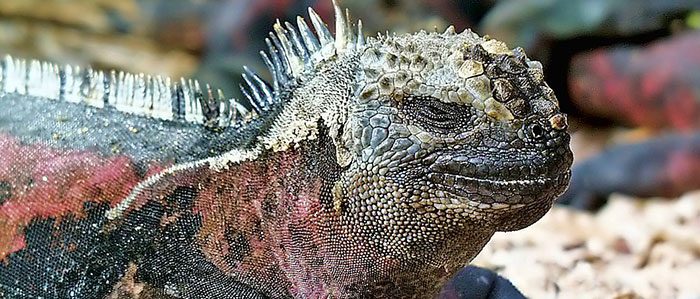
Marine Iguanas in Galapagos Islands and 10 facts that will surprise you!
In these islands, marine iguanas live a quiet life, sometimes interrupted by casual hunters or predators such as dogs or hawks, but they are generally diving free inside the bluest Pacific waters.
Marine iguanas sneeze all the time, are most of their time diving or under the rough sun, change their colors and eat algae: nothing really special. But they may seem lazy, and they are not! Their body is always working and functioning as a perfect machine.
1. No one like them anywhere else!
Marine iguanas are the only kind of seafaring lizards around the world.
2. Do they have enemies or predators?
Yes, of course they do. There’s no living species in the world that does not have an enemy or a predator instead, if that’s the case. The main marine iguanas’ enemies are the Galapagos hawks, as well as cats and dogs. Great blue herons eat their small hatchlings, so they also threat their species.
- However, humans have been their biggest enemies, since they introduced pollution, dogs, and cats, to the archipelago. Before that, they weren’t as hunted or endangered as they are now.
3. Their colors are unique
Marine iguanas are usually beige, brown, dark grey, or black. Nevertheless, mostly during the mating season, males enchant their future couples with bright colors, completely different from the typical ones.
4. The reason why they sneeze…
They swallow saltwater as they are eating, and when they go back to the surface that saltwater must disappear: marine iguanas have salt-excreting glands that help them on this purpose, and at the exact time they sneeze, these glands do their job.
5. … and the reason why they stay under the sun.
They are, as most reptiles, cold-blooded. This means that they won’t get the warmth they need if they do not get it directly from the sun. This sun warmth also helps them on digesting their food. So no, they aren’t lazy, they don’t sneeze and lay under the sun doing nothing!
6. Do you know how deep they can dive?
30 meters under the water, and 45 minutes is their limit to hold their breath.
7. They love mockingbirds!
Mockingbirds help iguanas from being attacked by Galapagos hawks. Mockingbirds make a distinctive sound which alerts the iguanas that they need to run and hide.
8. They lay only one egg!
Well, not exactly. Small female iguanas lay one egg, while large female iguanas lay up to 6 eggs.
9. These iguanas eat underwater…
… and off the water, too! They usually eat the algae found on the sea grounds, but they could also find a delicious plant on land. However, their favorite food is algae, since it’s the best type of plant for them to digest.
10. Why are some of them big?
If they eat plenty of algae, they will grow bigger and bigger than the ones that do not have enough supplies of algae. All females like the bigger males, and the bigger females lay the bigger eggs.
Dive with these sneezing buddies and discover their habitat up close, only with Galapagos Center Expeditions! Don’t let anyone tell you, it’s an experience you need to live.




